This article highlights nine goals designed to improve communication for nonverbal students with autism, using personalized strategies and interventions. It shares various methods, like visual aids, augmentative communication devices, and behavioral techniques. Together, these approaches help foster effective self-expression, social interaction, and overall communication skills in these wonderful students.
Let’s explore this together! By implementing these strategies, we can create a more inclusive environment that truly supports their unique needs. Remember, every little step counts in enhancing their ability to connect with the world around them!
Nonverbal students with autism encounter unique challenges when it comes to expressing their thoughts and needs. This often leads to frustration for both the children and their caregivers. Let’s explore this together! In this article, we’ll delve into personalized communication goals designed specifically to enhance the interaction abilities of these remarkable students. We’ll showcase effective strategies that can foster independence and social connection. What innovative methods can parents and educators leverage to bridge the communication gap? Together, we can empower these children to thrive in their daily lives!
At Rori Behavioral Innovations Inc., we use ABA therapy to create personalized goals for nonverbal students with autism. These goals for nonverbal students with autism come after thorough evaluations and focus on helping your child express their needs and emotions more effectively. For example, one goal might involve using visual aids, like pictures or symbols, to help communicate basic needs—this can significantly improve interactions with caregivers and peers. Research shows that ABA interventions can be moderately to highly effective in boosting language skills, both expressive and receptive. By customizing these goals, our therapists enable each child to progress at their own pace, fostering a sense of achievement and independence.
Key strategies we use include:
Children who receive at least 80% of their prescribed ABA hours often experience noticeable improvements, especially those who start with lower functioning levels. The success of ABA therapy hinges on how well it meets goals for nonverbal students with autism. These approaches not only enhance communication skills but also support overall social interactions and adaptive behaviors in children with autism who don’t use spoken language, leading to lasting improvements in their communication and independence.
Let’s explore this together! We’re here to help you every step of the way!

Cultivating social abilities is essential for reaching goals for nonverbal students with autism, as it lays the groundwork for meaningful interactions. There are some great approaches to consider, such as role-playing, social narratives, and peer modeling. Each of these can be tailored to help improve understanding and application of appropriate social behaviors, which is essential for achieving goals for nonverbal students with autism.
By weaving these strategies into daily life, parents and educators can create a well-rounded approach to achieving goals for nonverbal students with autism while enhancing social skills. Ultimately, this empowers children with limited communication to navigate social interactions more effectively. Let’s explore this together!
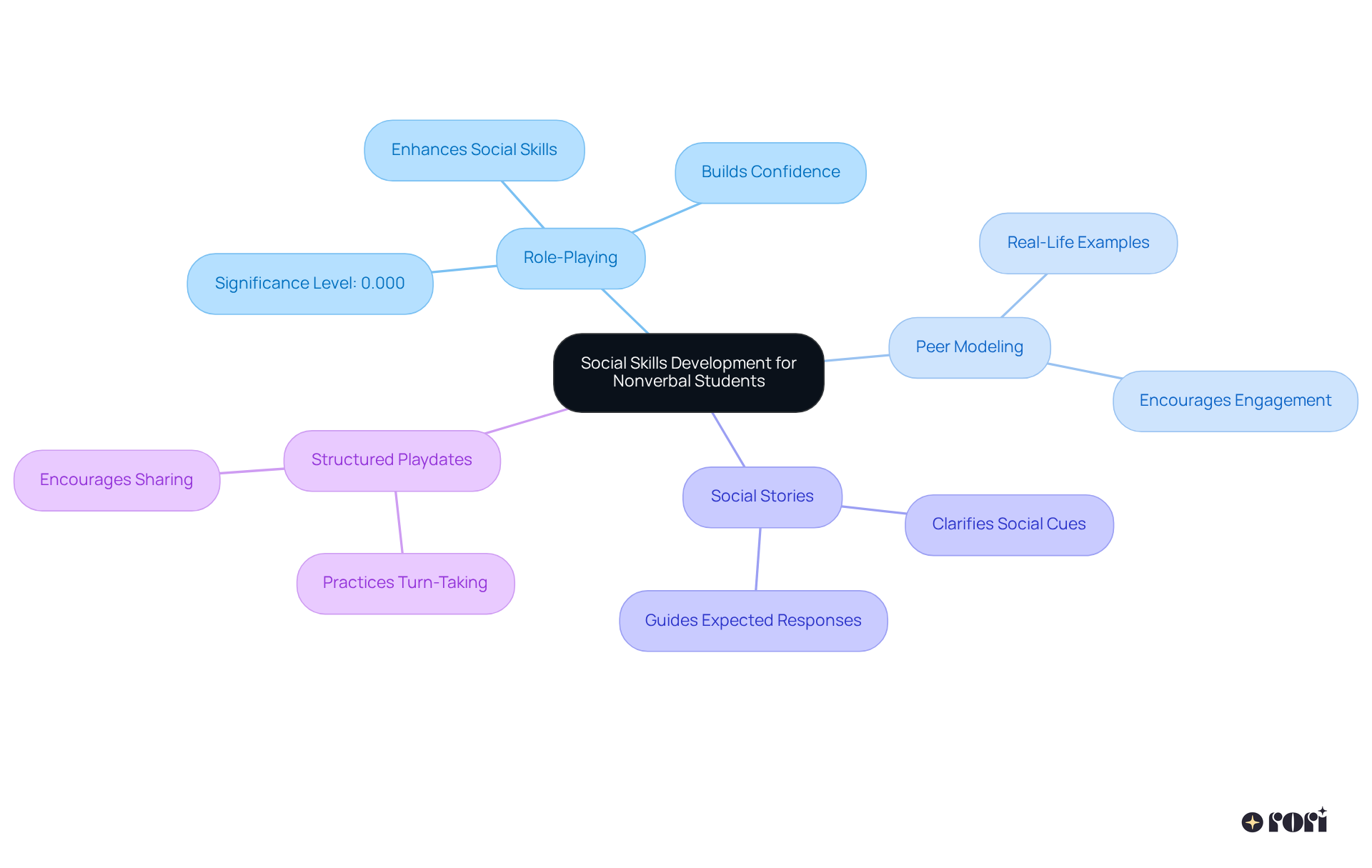
The goals for nonverbal students with autism focus on empowering them to share their thoughts and feelings effectively through expressive interaction. Techniques like augmentative and alternative means, sign language, and picture exchange systems play a crucial role in helping these students express their needs. For example, when a young child learns to use a device to ask for their favorite toy, it significantly boosts their ability to communicate wishes and engage with peers.
Let’s dive into some key strategies that can make a real difference:
AAC Devices: These handy tools help children express themselves through speech-generating devices or apps. Research shows that AAC interventions can enhance social interaction, with studies indicating that about one third to half of minimally verbal youngsters may benefit from these interventions. Interestingly, high-tech devices often yield better outcomes than low-tech options.
Sign Language: Introducing basic signs can provide a wonderful way for nonverbal individuals to express essential needs and emotions. Did you know that around 40% of youngsters with autism do not speak at all? This highlights the importance of using alternative means of expression to achieve goals for nonverbal students with autism. Studies have shown that sign language can enhance expressive capabilities, fostering a sense of connection and understanding.
Picture Exchange Communication System (PECS): This method encourages students to use pictures to communicate their wants and needs. PECS has proven effective in helping youngsters initiate requests and develop practical skills, ultimately improving their social interactions. It’s worth noting that about 25-30% of youth diagnosed with autism spectrum disorder remain minimally articulate or silent into adulthood, underscoring the ongoing need for effective communication methods.
Combining these approaches not only facilitates interaction but also supports the goals for nonverbal students with autism by encouraging self-expression. It allows children who don’t use words to engage more fully in their surroundings and connections. Let’s explore this together and see how we can support our children in their communication journey!

Receptive language abilities are essential for achieving goals for nonverbal students with autism, as they help them understand and respond effectively. By using strategies like visual aids, simple language, and consistent routines, we can really boost their understanding. For example, pairing verbal instructions with visual cues—like images or symbols—makes a big difference in comprehension and helps them follow directions. Regular practice in identifying objects and responding to questions reinforces these skills, leading to better communication outcomes.
Here are some key strategies to consider:
Research shows that early intervention and the use of visual aids can significantly enhance receptive language skills, helping to achieve goals for nonverbal students with autism. Language experts emphasize that these strategies not only improve understanding but also help young learners engage more actively in their educational settings. One expert noted, "Visual aids are essential in closing the gap for nonverbal youngsters, enabling them to associate words with meanings more effectively." Plus, studies indicate that children who interact with visual aids see a 30% improvement in their ability to follow verbal directions compared to those who don’t.
By weaving these strategies into everyday interactions, parents can create a nurturing learning environment for their kids. Let’s explore this together! We’re here to help you every step of the way!
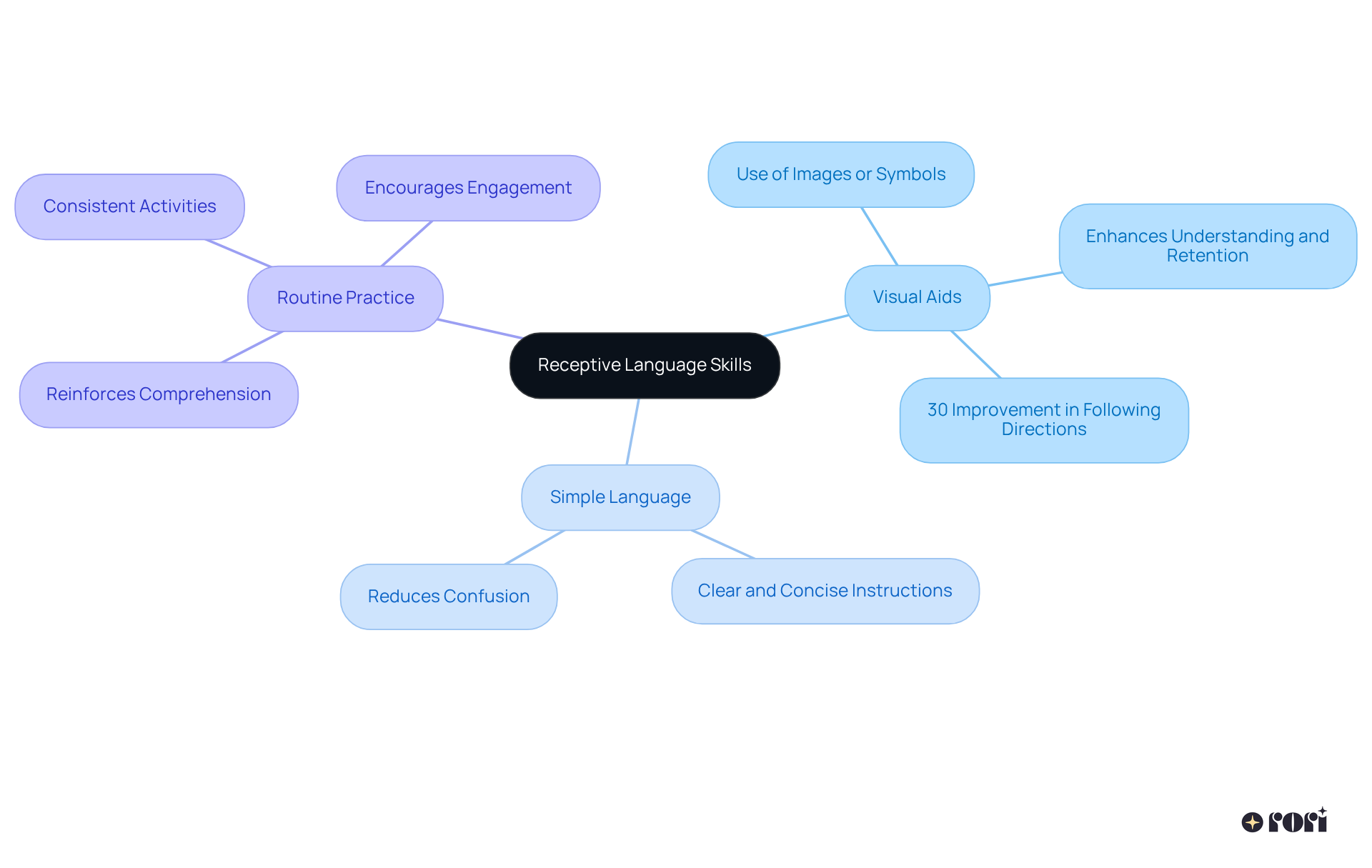
Goals for nonverbal students with autism are truly essential for helping them express their needs in everyday situations. These objectives often focus on teaching kids to use gestures, signs, or assistive devices to help meet goals for nonverbal students with autism, enabling them to request help, indicate preferences, or share discomfort. For example, one goal might involve showing a young person how to use a request board to ask for a snack. This not only enhances their ability to express themselves but also fosters a sense of independence in their daily lives.
Did you know that about 25-30% of preschool-aged children with ASD will be nonverbal or only minimally verbal by the time they start Kindergarten? This statistic highlights the challenges many young ones face when it comes to communication, reinforcing the importance of effective strategies.
Here are some key strategies to promote independence in communication:
Research shows that using boards for interaction can help in achieving goals for nonverbal students with autism, resulting in greater independence among these youths. Many studies suggest that individuals who utilize these tools are more likely to engage in social exchanges and effectively convey their needs. ABA therapists emphasize that fostering independence through interaction is crucial for achieving goals for nonverbal students with autism and enhancing their overall quality of life. As Rose Griffin beautifully states, "the ultimate goal is to help these students communicate and thrive across environments!" By applying effective methods and the latest techniques for teaching gestures and signs, caregivers and educators can create an environment that nurtures meaningful communication development.
Let’s explore this together! We’re here to help you every step of the way!
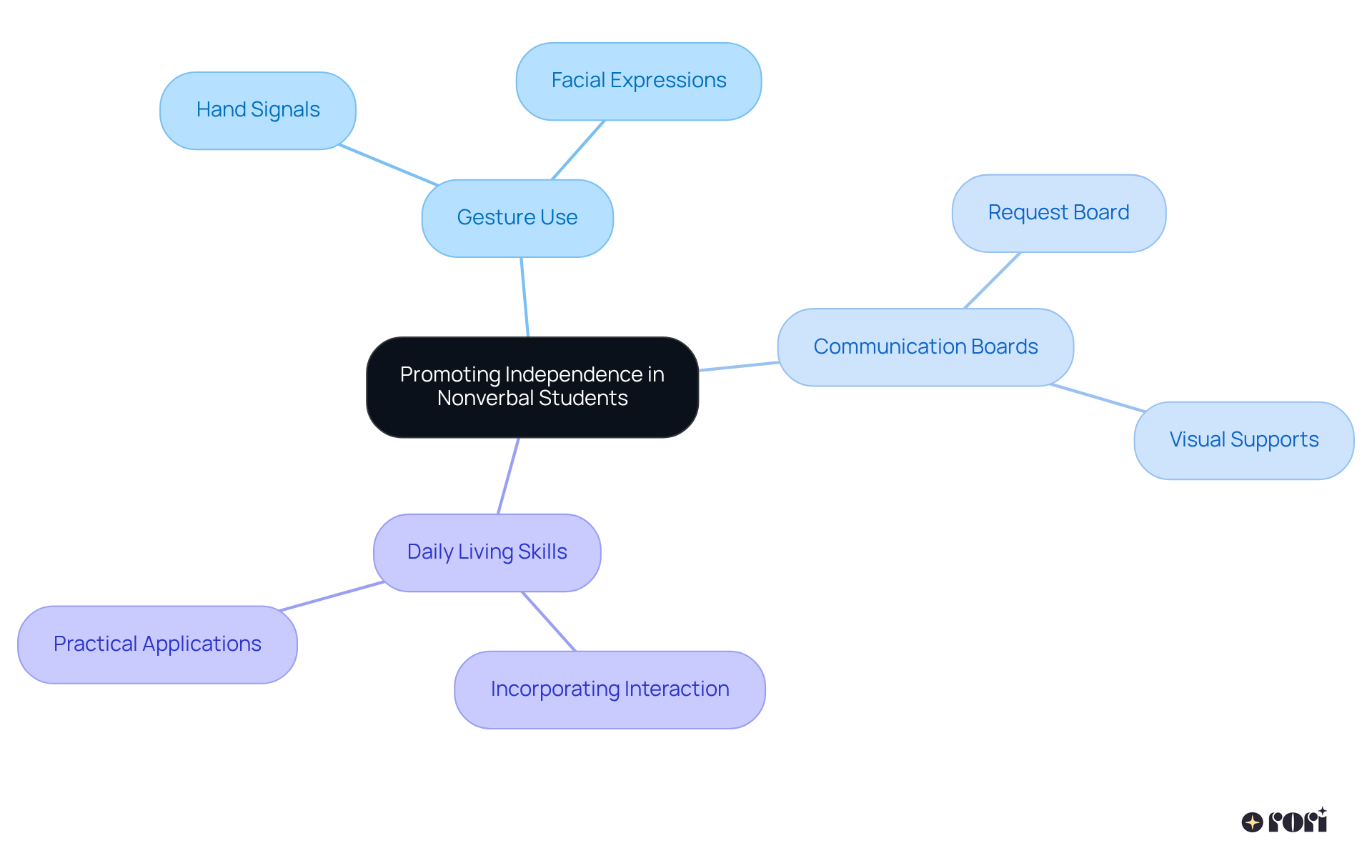
Goals for nonverbal students with autism are crucial for helping them manage their emotions and reactions through behavioral regulation. By implementing techniques like teaching calming strategies, using visual schedules, and keeping routines consistent, we can really enhance their emotional regulation. For example, deep breathing exercises and mindfulness practices empower students to cope with overwhelming situations, fostering a sense of control and improving their ability to communicate effectively.
Let’s dive into some key strategies!
Calming Techniques: Methods like deep breathing and mindfulness can really help children manage emotional dysregulation. It’s best to introduce these techniques gradually, starting when your little one is in a positive emotional state, so they’re more open to learning. Studies show that kids who engage in organized calming methods often demonstrate better emotional self-regulation. They learn to recognize when they’re feeling overwhelmed and can use strategies like counting or taking breaks to regain their composure.
Visual Schedules: Visual aids that outline daily activities and expectations can provide clarity and reduce anxiety for nonverbal individuals. By linking emotions with visual representations, kids can better understand their feelings and the context of their responses.
Routine Consistency: Establishing predictable environments is key to reducing anxiety and promoting self-management. Regular routines help children anticipate what’s next, which can lessen feelings of uncertainty and emotional overload. Psychologists emphasize the importance of teaching goals for nonverbal students with autism through visual supports, like emotion charts, which can aid in labeling feelings and understanding emotional responses.
Parental Involvement: Engaging parents in the emotional regulation process is vital! By promoting emotional awareness and self-regulation skills, caregivers and educators can create supportive environments that help nonverbal students thrive.
We’re here to help you every step of the way! Let’s explore these strategies together and see how they can make a difference in your child’s emotional journey.
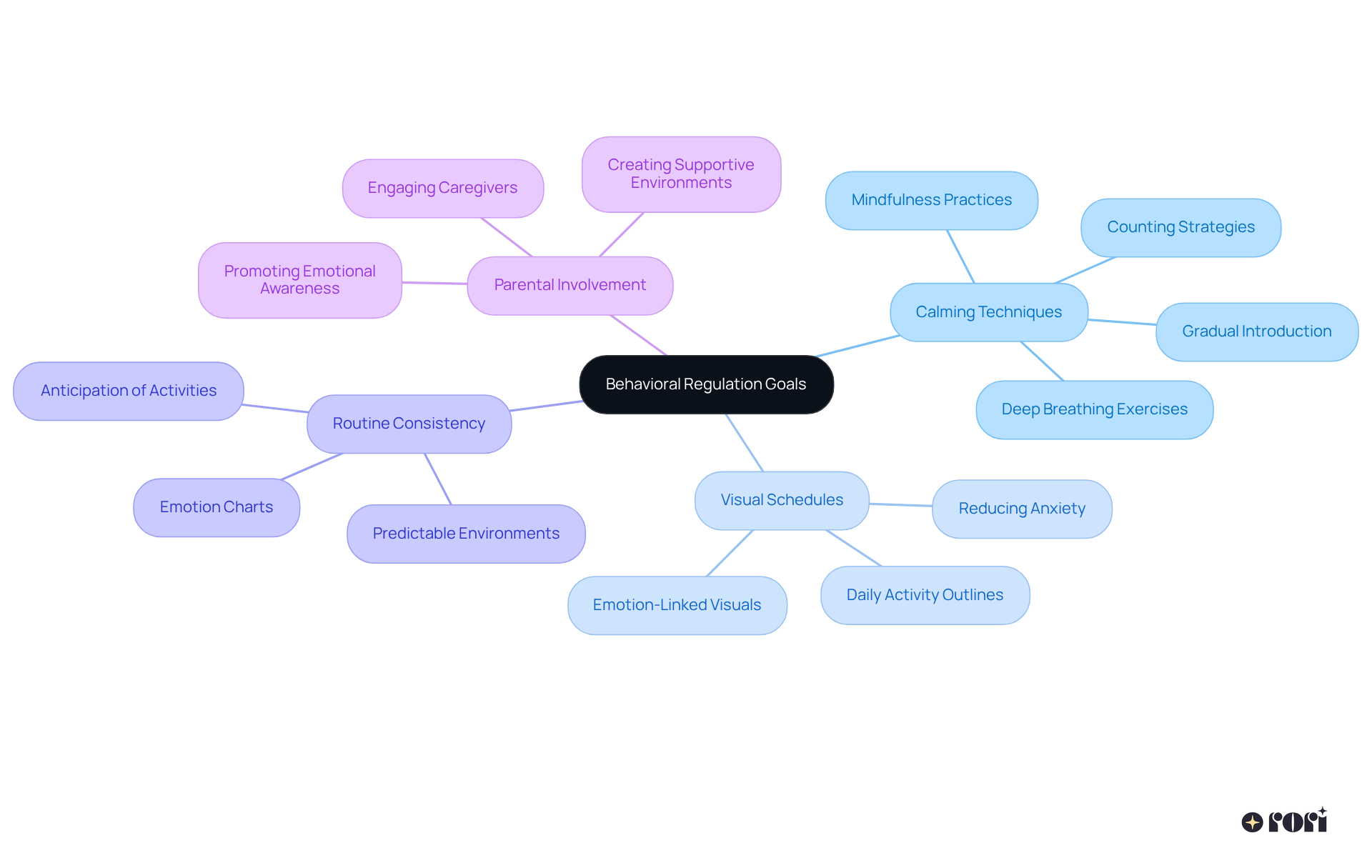
Technology-enhanced interaction strategies are truly changing the game in helping achieve goals for nonverbal students with autism! They offer innovative solutions that significantly boost their ability to express themselves and connect with others. At the forefront of this transformation are speech-generating devices (SGDs), which allow young individuals to produce spoken language through synthesized or digitized speech. These devices come in many forms, from dedicated gadgets with user-friendly interfaces to tablet-based apps that can be customized to meet individual needs.
Research shows that SGDs can lead to remarkable improvements in interaction outcomes. For example, studies indicate that:
The latest SGDs are designed to be user-friendly and flexible, allowing for real-time updates and personalized interaction experiences. This adaptability is crucial! It gives young individuals the freedom to select images or phrases that resonate with their thoughts and feelings, ultimately enhancing their social interactions and reducing feelings of isolation.
In addition to SGDs, messaging applications play a vital role in facilitating expressive interaction. These apps can be tailored to individual preferences, making them a fantastic tool for engaging students in interactive learning environments. By weaving technology into interaction strategies, parents and educators can establish goals for nonverbal students with autism, empowering them to participate more fully in educational and social settings.
All in all, the combination of SGDs and messaging apps marks a significant leap forward in augmentative and alternative communication (AAC). They provide essential tools to help achieve goals for nonverbal students with autism to thrive. As technology continues to evolve, the potential for these devices to enhance interaction abilities and improve the quality of life for youngsters with autism is truly exciting. Let’s explore this together!

Parent-led initiatives play a vital role in enhancing interaction goals at home. By teaching parents effective ways to convey messages—like using visual aids and demonstrating language—we can significantly boost their child's development. For instance, parents can practice using augmentative and alternative communication (AAC) devices during daily routines, helping their little ones feel more comfortable with these tools. Recent workshops have been all about equipping parents with practical skills, and the results are impressive: parents' total implementation scores increased from 45.59% at entry to 69.75% at exit!
Research shows that parent training initiatives can lead to remarkable improvements in children's expressive skills. A meta-analysis highlighted a mean Hedges effect size of 0.92 for receptive language, emphasizing just how crucial parent involvement is in language development. Family therapists often remind us that parents are typically the most influential figures in their children’s growth, which makes their active participation essential.
To truly empower families, it’s important to provide resources and training that enable parents to take charge of their child's interaction journey. Sharing materials that outline effective ways to convey messages—like labeling items and using visual supports—along with offering ongoing support, can help parents weave these tools into their daily lives. Plus, integrating non-verbal techniques, such as gestures and facial expressions, can further enhance their child's ability to express themselves and connect with their surroundings. Let’s explore this together! 🌟
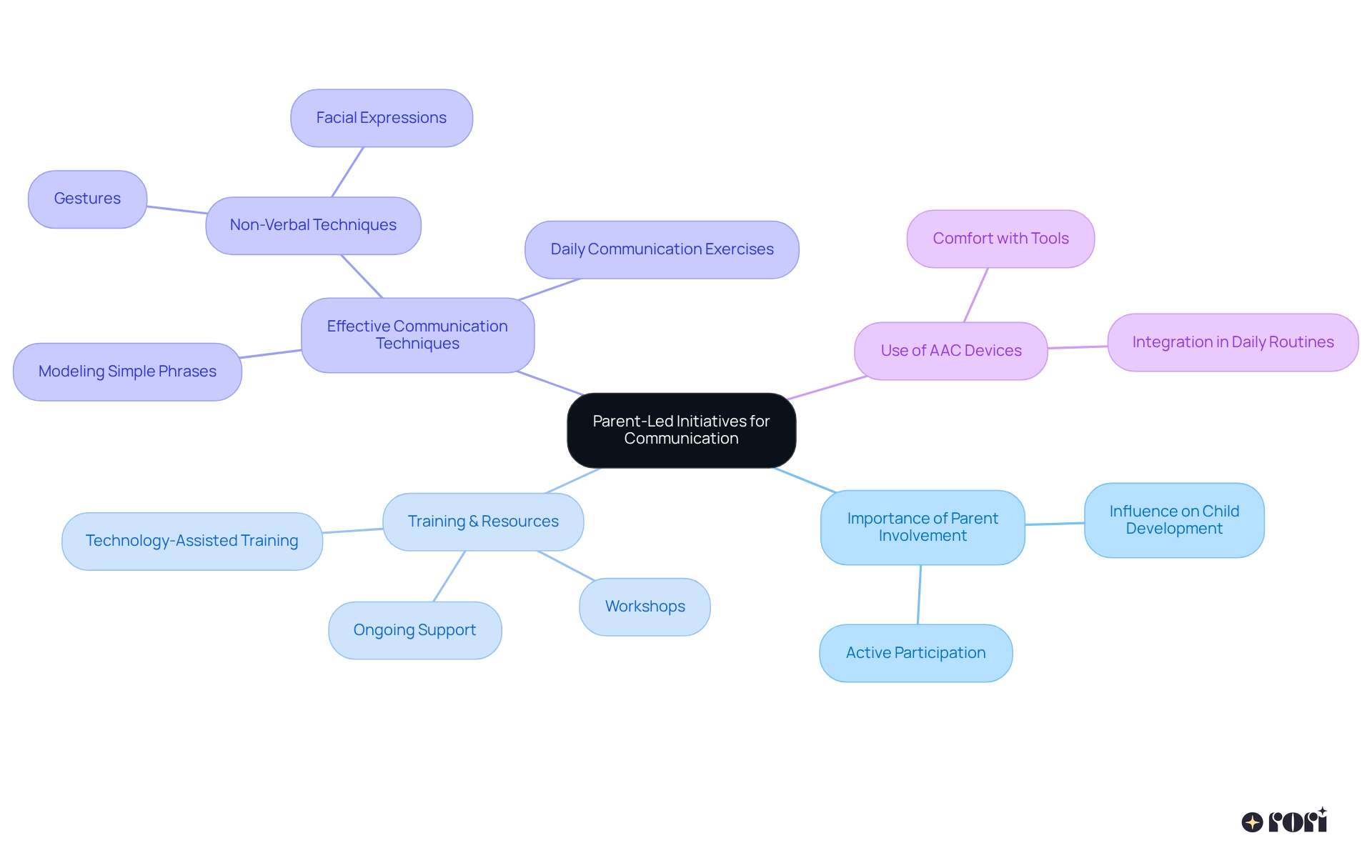
Collaborative goals for nonverbal students with autism between educators and therapists are essential for creating a unified approach to support them. When these two groups work together, it ensures that the strategies used in the classroom align seamlessly with those applied during therapy sessions. For example, educators can easily weave interaction goals into their lesson plans, while therapists can share valuable insights on effective classroom strategies. This teamwork nurtures a consistent environment that significantly enhances the educational and interaction experiences for young learners.
Here are some key strategies to foster this collaboration:
The significance of teamwork in autism support is echoed by educational leaders who stress that collaborative practice is vital for achieving the best outcomes for students. As Villeneuve & Hutchinson noted, "the goal of collaboration is for students to experience improved outcomes by receiving the most effective educational services to which they are entitled." Additionally, a study revealed that 74% of participants felt that collaboration positively impacted student success. By prioritizing collaboration, educators and therapists can create a supportive framework that allows students with communication challenges to truly thrive. Let’s explore this together!
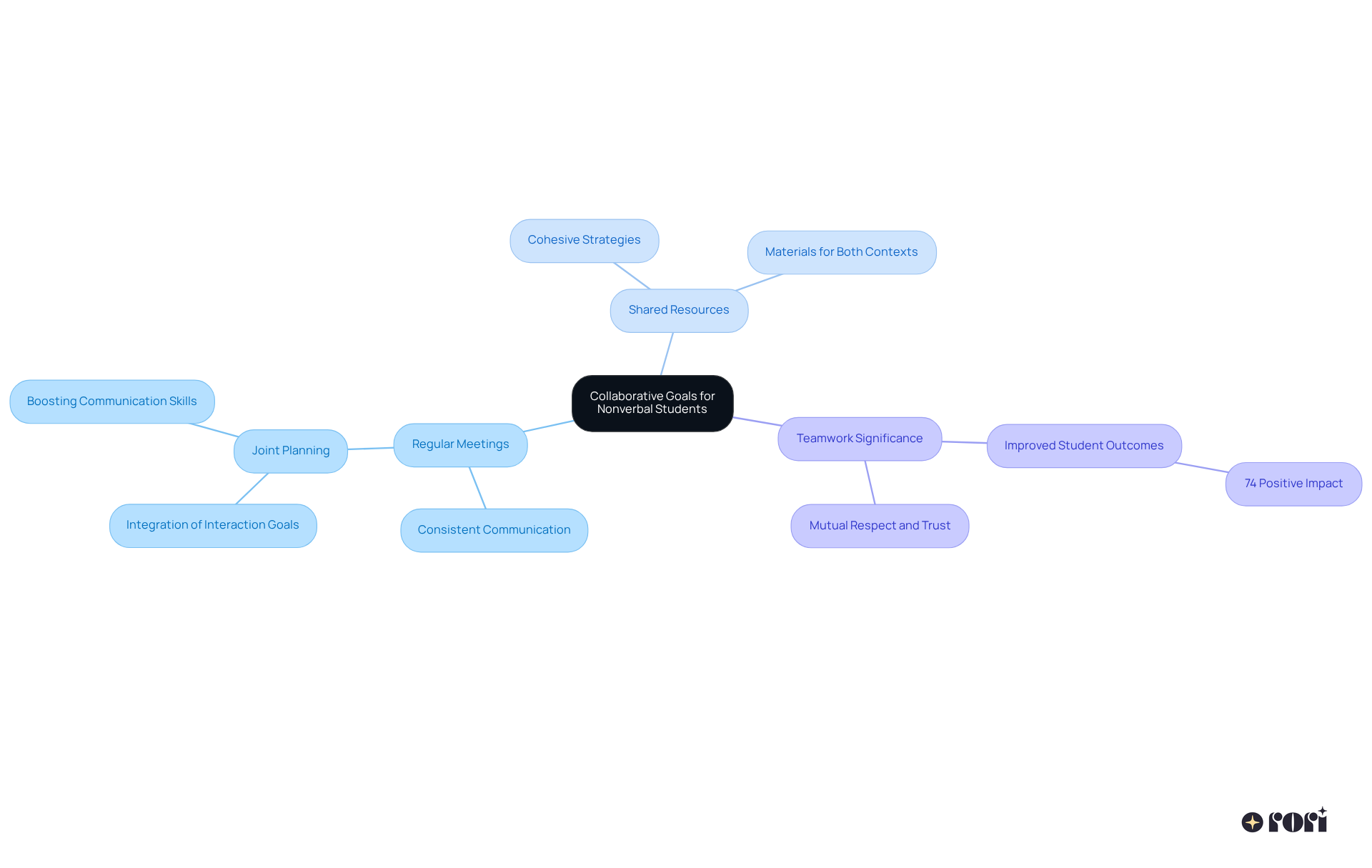
Assessing how we advance interaction goals for nonverbal students with autism is so important for understanding how well strategies are working. By using systematic data collection methods—like tracking how often successful interactions happen and how Augmentative and Alternative Communication (AAC) devices are used—we can gain valuable insights into a young person's developmental journey. Regular evaluations give therapists the chance to tweak their approaches, ensuring they fit the young one's evolving needs. For instance, if a child consistently uses a device to express their needs, therapists can introduce more complex vocabulary to help them grow even further.
Here are some key strategies for effective communication tracking:
By focusing on these strategies, therapists can create an environment that nurtures the development of communication skills. This ultimately enhances the child's ability to express themselves and connect with others. Let’s explore this together and support our children every step of the way!
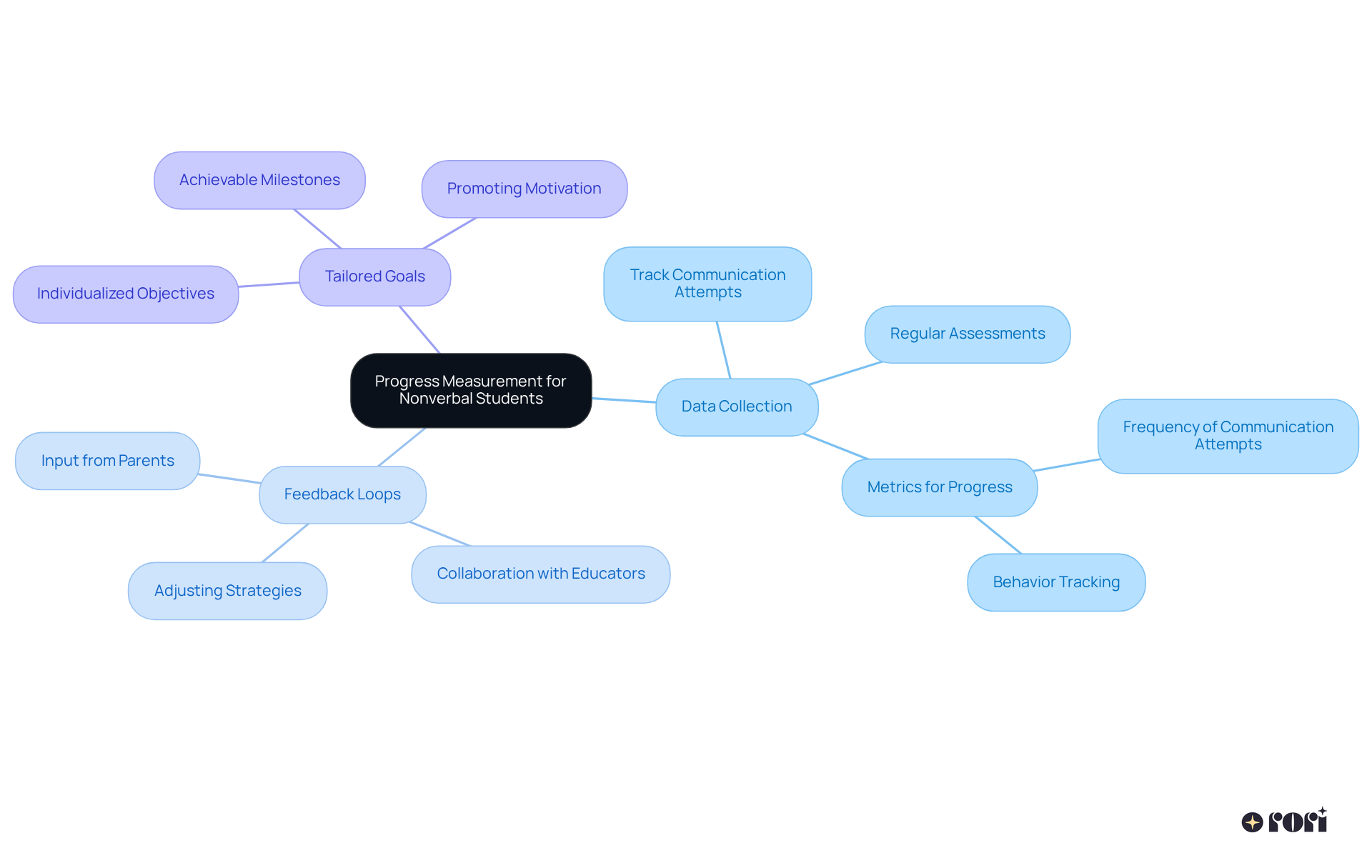
Nonverbal students with autism often encounter significant hurdles when it comes to expressing their needs and emotions. However, personalized communication goals can truly transform their ability to interact. This article shines a light on the importance of tailored strategies that empower these children to communicate effectively, fostering both independence and social connection. By embracing methods like visual supports, AAC devices, and collaborative efforts between parents and educators, we can make remarkable progress in enhancing their communication skills.
Key insights shared here highlight the effectiveness of ABA therapy in promoting both expressive and receptive language skills. We also see how technology plays a pivotal role in facilitating communication, along with the value of social skills development through structured activities. Furthermore, the focus on behavioral regulation and parent-led initiatives emphasizes the comprehensive approach needed to support our nonverbal students. Each of these elements contributes to a holistic understanding of how we can bridge the communication gap faced by these remarkable individuals.
Ultimately, improving communication for nonverbal students with autism is a journey that requires collaboration among families, educators, and therapists. By embracing innovative strategies and nurturing a supportive environment, we can empower these children to thrive in their daily lives. As the landscape of communication continues to evolve, the potential for these students to engage meaningfully with their peers and caregivers is both exciting and essential. Let’s continue to advocate for and implement these strategies, ensuring every child has the opportunity to express themselves and connect with the world around them. We’re here to help you every step of the way!
What is Rori Care's approach to ABA therapy for nonverbal students with autism?
Rori Care uses ABA therapy to create personalized communication goals for nonverbal students with autism, focusing on helping them express their needs and emotions effectively through thorough evaluations.
What are some examples of communication goals for nonverbal students?
Examples include using visual aids like pictures or symbols to communicate basic needs, which can improve interactions with caregivers and peers.
How effective is ABA therapy for improving language skills in nonverbal students?
Research indicates that ABA interventions can be moderately to highly effective in boosting both expressive and receptive language skills for nonverbal students with autism.
What key strategies are utilized in Rori Care's ABA therapy?
Key strategies include visual supports, modeling preferred interaction behaviors, and reinforcement through positive feedback to encourage interaction efforts.
What is the impact of receiving adequate ABA therapy hours?
Children who receive at least 80% of their prescribed ABA hours often experience noticeable improvements, especially those starting with lower functioning levels.
How does Rori Care enhance social skills for nonverbal students?
Rori Care enhances social skills through techniques such as role-playing, social narratives, peer modeling, and structured playdates, which help students practice appropriate social behaviors.
What role does role-playing play in social skills development?
Role-playing allows students to practice social scenarios in a safe environment, significantly enhancing their social skills and self-confidence.
How do peer modeling and social stories contribute to social skills?
Peer modeling provides real-life examples of suitable social behaviors, while social stories help students understand social cues and expected responses, improving their social interactions.
What are expressive communication goals for nonverbal students?
Expressive communication goals focus on empowering nonverbal students to share their thoughts and feelings effectively through techniques like augmentative and alternative communication (AAC), sign language, and picture exchange systems.
What are AAC devices, and how do they assist nonverbal students?
AAC devices are tools that help children express themselves through speech-generating devices or apps, enhancing social interaction and communication capabilities.
How does sign language benefit nonverbal students with autism?
Sign language provides a means for nonverbal individuals to express essential needs and emotions, fostering connection and understanding.
What is the Picture Exchange Communication System (PECS)?
PECS encourages students to use pictures to communicate their wants and needs, helping them initiate requests and improve their social interactions.
Why is it important to combine various communication approaches for nonverbal students?
Combining different approaches facilitates interaction and supports expressive goals, allowing nonverbal children to engage more fully with their surroundings and connections.